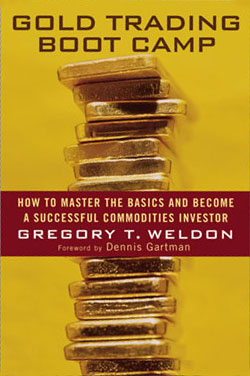Gold ETFs are a hybrid between mutual funds and individual stocks. They are like gold mutual funds in that they are funds that hold an entire portfolio of assets. They are like individual stocks in that they trade on stock exchanges, unlike mutual funds, which makes them easy to buy and sell.
The basic idea behind ETFs is that they, like mutual funds, offer instant diversification. However, there are also ETFs that don’t act like traditional mutual funds, in that they don’t hold a portfolio of stocks or other securities, but instead, they hold physical assets. A popular class of these ETFs are the various gold exchange-traded funds, which hold gold bullion and are designed to be “the next best thing” to physical gold.
Gold ETFs are intended to mirror the per-ounce price of gold. The idea is that when investors buy shares of the ETF, the ETF adds gold; and when investors sell shares of the ETF, the ETF sells gold. This way, shares of the ETF should move in tandem with the price of gold—and as people buy or sell shares of the ETF, this should move the price of gold up or down accordingly.
Gold and ETF Disequilibrium
Unfortunately, gold ETFs do not always work as they should. Sometimes they move with greater velocity than gold, other times they move at a slower pace—or possibly in the opposite direction. Generally, ETFs are a decent approximation of gold, but they are not as perfect as they were intended to be. Why is this?
Well, one reason is that there is ample speculation that the gold ETFs do not actually hold all the gold they say they do. If fund managers don’t buy gold as shares of their ETF are bought, then this would result in the share price of the ETF going up faster than gold, all other things being equal. If the cause for discrepancy had to do with the supply and demand of ETF shares versus the price movement of physical gold, then this would represent an arbitrage opportunity for investors, who would quickly come in and buy (or sell) the over-(or under-)priced shares, causing the ETF and gold to return to an equilibrium. This doesn’t happen, though, and that is, in part, because of the somewhat widely held belief that the ETFs are not entirely on the up-and-up.
‘Lack of Custodial Controls’
SPDR Gold Shares, Ticker: GLD, is the granddaddy of all gold ETFs. It has total assets of over $56 billion, and has been around since 2004. However, despite its pedigree, there are some serious questions about whether or not G.L.D. actually had the G.O.L.D. it says it does. The firm’s gold holdings are not audited, and some maverick analysts have uncovered evidence to suggest that something may not be quite right.
Analyst James Turk had this to say of the GLD fund when it first launched:
“The risks of the fund appear too great. Until more questions are answered and/or the fund’s structure is changed to eliminate its loose custodial controls, I do not recommend that these funds be purchased.”
As a result, Mr. Turk was threatened with a lawsuit unless he retracted his analysis. He refused. The representatives from GLD backed off, which suggests that perhaps Turk was on to something. Years later, those custodial controls have not improved.
What are these “custodial controls” of which Turk speaks? Well, banking giant HSBC is the gold bullion custodian for GLD, which means it owns the vaults where GLD’s gold bars are supposed to be located. Unfortunately, the prospectus for GLD specifically states that “the Custodian is not liable for the acts or omissions of its subcustodians” and “Shareholders cannot be assured that the Trustee will be able to recover damages from subcustodians… for any losses relating to the safekeeping of gold by such subcustodian.”
Is it realistic to worry that GLD may not be putting gold bars into HSBC’s vaults as much as it should? You bet it is. After all, when big traders on the London spot market trade gold, they rarely physically move the bars from location to location—it’s too time-consuming, especially when the accounts are buying and selling all the time. Instead, they use paper claims—I.O.U.s—and the problem is that these I.O.U.s may or may not correspond to actual bars of gold.
It is also stated in the prospectuses for GLD and the related SLVR ETFs that investments in the funds are supposed to be similar to investments in the physical precious metals. Just similar, not identical. It is not clear if GLD really has the gold it says it does, or whether it has paper promises thought to be “as good as gold.” Well, paper is never as good as gold, and shares in an ETF are ultimately just paper.
Advantages of ETFs
Does this mean ETFs should be entirely ignored? Of course not. ETFs, like most any investment vehicle, have their purposes. For instance, if you want to trade gold, rather than invest in it, than ETFs are great. Buying and selling physical gold isn’t really a feasible trading strategy, and trading futures and options is a whole other ballgame. Although these ETFs may be holding some (maybe even a lot of) paper claims, there’s no doubt that they hold a good deal of gold, and thus, for the short-term, the ETFs trade very much like gold would. Even if you’re a gold investor who holds physical gold, you may want to do some trading, perhaps as a hedge, and ETFs are a good vehicle for doing so.
Another way ETFs can be used is in your IRA or 401(k). Self-directed IRAs can hold gold bullion, but it may not always be worth the hassle of setting things up, particularly if you don’t want to do a lot of gold buying for the account, so ETFs can be a good alternative. There are no provisions for having gold in a 401(k) account, so ETFs really are the next best thing, especially if your employer matches all or a portion of your contributions.
List of Gold ETFs
Since the debut of GLD in 2004, several ETF products with a focus on gold have come to the market. Many, like GLD, try to mimic the price of gold. Others are leveraged, so their aim is to move by twice the amount that gold does. Others are bearish funds, which means they are intended to go up when gold goes down, and vice versa. And finally, there are even leveraged bearish ETFs. Below is a list, with the individual ETFs sorted within each category from largest (in terms of assets) to smallest:
Standard Gold ETFs
- streetTRACKS Gold Shares ETF (Ticker: GLD)
- iShares COMEX Gold Trust Fund (Ticker: IAU)
- ETFS Physical Swiss Gold Shares ETF (Ticker: SGOL)
- PowerShares DB Gold Fund (Ticker: DGL)
- ETFS Asian Gold Trust ETF (Ticker: AGOL)
- E-TRACS S&P 500 Gold-Hedged Index ETN (Ticker: SPGH)
Bearish (Short) Gold ETFs
- PowerShares DB Gold Short ETN (Ticker: DGZ)
Leveraged Gold ETFs
- PowerShares DB Gold Double Long ETN (Ticker: DGP)
- ProShares Ultra Gold ETF (Ticker: UGL)
- FactorShares 2X Gold Bull/S&P 500 Bear ETF (Ticker: FSG)
Leveraged Bearish (Short) Gold ETFs
- PowerShares DB Gold Double Short ETN (Ticker: DZZ)
- ProShares UltraShort Gold ETF (Ticker: GLL)



